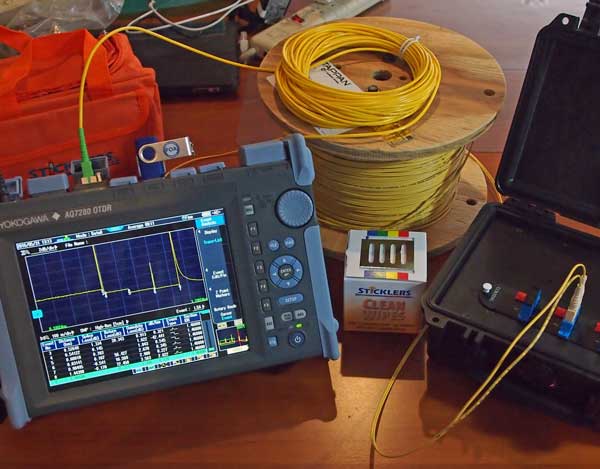Engineers utilize the optical fibre diameter analyser to verify fibre uniformity.
Engineers utilize the optical fibre diameter analyser to verify fibre uniformity.
Blog Article
The Role of Optical Fibre Screening in Ensuring Quality and Performance in Connection Solutions
In today's quickly developing electronic landscape, the significance of optical fibre screening can not be overstated, as it serves as a keystone for making sure the quality and efficiency of connection remedies. As innovation continues to advance, the future of optical fibre testing presents intriguing challenges and possibilities that warrant closer exam.
Relevance of Optical Fiber Testing
The importance of optical fiber screening can not be overstated in ensuring the honesty and performance of communication networks. As the backbone of modern-day telecoms, optical fibers assist in high-speed data transmission, making their dependability vital to functional success. Examining works as an aggressive action to identify potential issues such as signal loss, depletion, and physical damage, which can endanger network performance.
Routine testing enables the confirmation of installation quality and the detection of flaws that can affect data honesty - robotic vision. By utilizing rigorous testing methods, network operators can reduce the risks connected with network failures, consisting of downtime and monetary losses. Furthermore, optical fiber testing makes sure conformity with industry requirements and laws, enhancing the overall quality of solution given to end-users.
Inevitably, the methodical analysis of optical fibers adds to the longevity and performance of interaction systems. It enables stakeholders to make enlightened decisions pertaining to maintenance, upgrades, and troubleshooting. In a landscape where information is increasingly essential, focusing on optical fiber screening is necessary to maintaining robust and efficient connection options, consequently sustaining the needs of modern digital settings.
Kinds of Optical Fibre Examinations
Numerous testing techniques are utilized to make certain the capability and integrity of optical fibers within interaction networks. These examinations can be generally classified right into 2 main kinds: installment tests and upkeep tests.
Setup tests are conducted immediately after the installation of optical fiber cable televisions to validate their efficiency and stability - ofda. One of the most common installment examinations include Optical Time-Domain Reflectometry (OTDR) tests, which examine the high quality of the fiber by identifying mistakes or breaks, and end-to-end loss examinations, which determine the overall optical loss from one end of the fiber to the various other
Upkeep examinations, on the other hand, are executed occasionally to make certain continuous efficiency and identify prospective problems gradually. These consist of aesthetic examination, which look for physical problems or inappropriate installations, and continuity examinations, which verify that the signal can travel through the fibre without disturbance.
In addition, progressed tests such as Polarization Setting Dispersion (PMD) and Chromatic Dispersion (CD) examinations can be carried out to examine the fiber's efficiency under numerous problems. By utilizing these varied testing methods, service technicians can keep high requirements of quality and reliability in find out here now optical fibre networks.
Benefits of Normal Testing
Regular testing of optical fibres plays an important function in preserving the general performance and reliability of communication networks. click this By carrying out routine analyses, companies can make sure that their fiber optic setups meet industry standards and operate effectively. This proactive strategy assists to determine prospective weaknesses and deterioration with time, enabling for timely treatments before issues escalate.
Cost-effectiveness is an additional advantage. By addressing minor concerns early, organizations can prevent the high costs related to significant repair work or system failures. Normal screening likewise cultivates conformity with regulatory demands, making certain that the network adheres to required safety and security and performance requirements.
Typical Concerns Identified
Recognizing common problems in optical fiber networks is essential for maintaining optimum efficiency and reliability. Various factors can add to disturbances, consisting of physical damages, bad setup methods, and environmental impacts.
Physical damage, such as bends, breaks, or abrasions, can considerably deteriorate signal top quality. Inappropriate installment methods, consisting of excessive stress or inadequate securing of cords, might cause boosted depletion and loss of connection. In addition, ecological elements such as temperature fluctuations, moisture access, and rodent disturbance can compromise the integrity of the fiber.
Adapter issues likewise often emerge, with inappropriate alignment or contamination resulting in boosted insertion loss. Splicing mistakes can introduce considerable signal deterioration if not carried out with accuracy.

Addressing these usual problems through normal optical fiber testing not only boosts network dependability yet also enhances overall efficiency, making certain that connection options stay robust and efficient.
Future Fads in Evaluating
As the need for high-speed connection continues to rise, the future of optical fiber testing will significantly concentrate on automation and progressed analytics. The combination of expert system (AI) and device learning (ML) in screening processes will enable a lot more efficient information analysis and predictive upkeep, decreasing downtime and boosting general network reliability. Automated testing solutions will streamline the assessment and certification of fiber networks, reducing human mistake and boosting screening throughput.
One more substantial trend is the adoption of remote screening modern technologies. As the deployment of fiber networks increases into remote and underserved areas, remote screening capacities will certainly allow service technicians to check and diagnose network conditions without physical existence, consequently lowering functional costs and enhancing reaction times.
Moreover, there will certainly be a change in the direction of even more thorough testing standards that encompass not only standard loss measurements however additionally efficiency metrics such as latency and transmission capacity use. This alternative method will promote much better network administration and optimization strategies.
As these fads advance, the optical fibre testing landscape will certainly not only enhance the top quality and effectiveness of connectivity remedies however also sustain the growing intricacies of contemporary communication networks.
Verdict
In conclusion, optical fibre screening offers as a fundamental element in keeping the integrity and efficiency of interaction networks. The recurring commitment to regular testing not just boosts data transmission however likewise straightens with industry requirements, fostering dependability in network frameworks.
Report this page